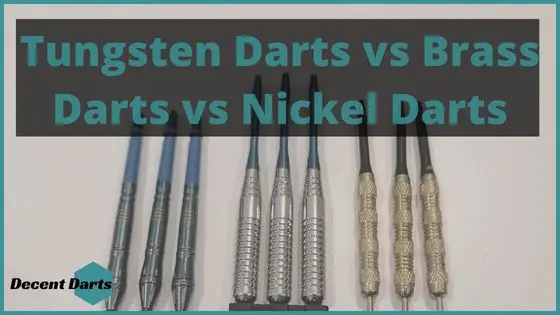Research shows that about 17 million Americans play darts and globally, this number will be much higher.
Though darts started as a pub game, it has gained popularity over the years with prize money and the level of competition being at an elite level.
Related – How much do professional dart players make
Part of this comes down to the quality of equipment and your darts are key to this.
Darts are often shown to be generic with the general public picturing a brass dart that you’ll find in a bar but there are actually a number of dart materials and endless designs to choose from.
Making a final decision on which dart types to select can be challenging due to the countless designs and materials available, however, it doesn’t necessarily have to be challenging.
Once you understand the basics of each type, it will be easier for you to decide.
Let’s help you discover which type of dart best suits your needs as we do a head to head of tungsten darts vs brass darts vs nickel darts.
Tungsten Darts vs Brass Darts vs Nickel Darts
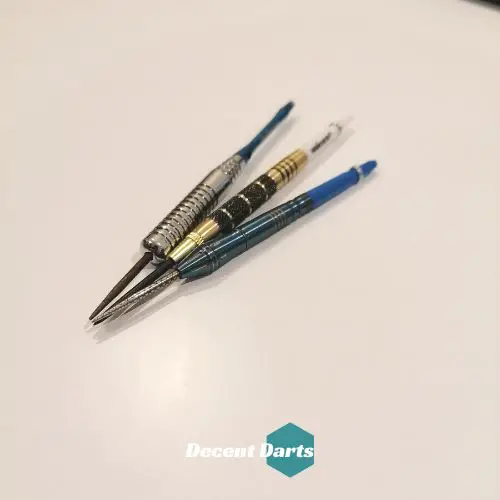
Tungsten darts are the highest quality and the most popular darts due to their durability, lightweight, and slimmer barrels.
Tungsten is a dense metal meaning a dart can be made lighter or heavier whilst maintaining a slim barrel profile.
We’ll explain the importance of this later but essentially, the slimmer the dart the easier it is to group darts together and the better your chance of scoring highly (provided you have the accuracy).
While Tungsten darts are popular, brass darts are the most common types because they are cheaper and usually come free with dartboards making them cost-effective and an ideal choice for starters.
Nickel darts are rarely manufactured now and are more of a nostalgic dart rather than one for performance.
They are an in between version of a brass and tungsten dart but the introduction of tungsten darts basically made nickel silver darts obsolete.
If you want a cheaper dart, choose brass. If you want to spend a bit more (£5/$7 more) then opt for tungsten.
Tungsten Darts
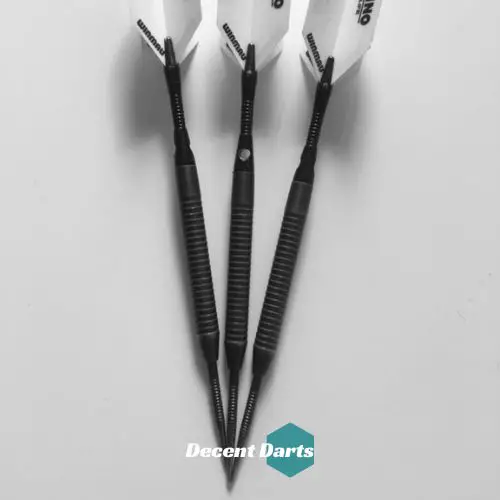
Most professionals prefer tungsten darts when playing darts due to their unique features. Some of the features that make tungsten darts stand out include:
Density
The main feature that makes Tungsten the most-preferred material in making darts is its high density. With a high density of 19.3 g/cm3, Tungsten is two times denser than brass with 8.7 g/cm3.
With such density, you will notice that tungsten darts are smaller than brass or nickel darts but weigh the same.
It is imperative to note that tungsten darts are not made from 100% pure tungsten metal. Rather, manufacturers make an alloy by mixing Tungsten with nickel.
Typically, you can get tungsten darts with 60%, 70%, 80%, 90%, 95%, or 97% tungsten.
The higher the percentage of tungsten used, the better quality the dart and ultimately the more expensive that dart will be.
Reduced Size
Due to their high density, tungsten darts will have the same weight as other darts but will be smaller.
For instance, a dart with 97% tungsten and 22g will measure 50 by 6.3mm, while a brass dart of the same weight measures 57.5 by 8.9mm.

Small-sized darts have numerous benefits, such as:
- Travel fast with less drag
- Stable and straighter flight path
- Can fit in tighter and smaller areas like bullseye or trebles (ideal for grouping and using markers)
- Fewer bounce outs
Related – How to reduce bounce outs
With the reduced size of tungsten darts, you will enjoy higher accuracy. More so, you can fit numerous darts on the dartboard.
Just note that by smaller dart – we essentially mean a thinner dart and not one that is short in terms of length. Thinner darts have benefits whereas the length of the dart would mainly be thrower preference.
Durability
A dart’s durability is largely dependent on the usage frequency, the material, and how players grip them.
Since Tungsten is tougher than nickel and brass, it is more durable. If you frequently play using brass or nickel darts, you might replace them within 6-12 months.
On the other side, tungsten darts with over 80% tungsten can go for several years without replacement.
Brass Darts
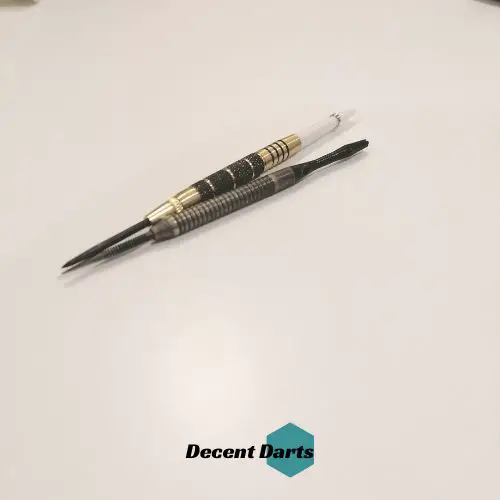
When you buy a dartboard, it comes with standard brass darts that you can use to practice playing darts.
The brass darts are ideal if you are beginning your darts journey and just looking to learn the game and learn how to hold and throw a dart.
Brass darts are less expensive because they are made from copper and zinc alloy, which is soft and easy to machine.
The barrels of brass darts are in different sizes and shapes, ranging from ringed to knurling grips. These barrels are thicker than those of tungsten/nickel darts and thus are easier for a beginner to better grip and hold.
Whether you want a lightweight, medium, or heavyweight dart, brass darts are available in different sizes and weights.
** Though the heavier a brass dart is, the more substantial the thickness of the barrel. Anything over 30g for a brass dart will be difficult to hold and will block a segment easily once thrown.
Nickel Darts
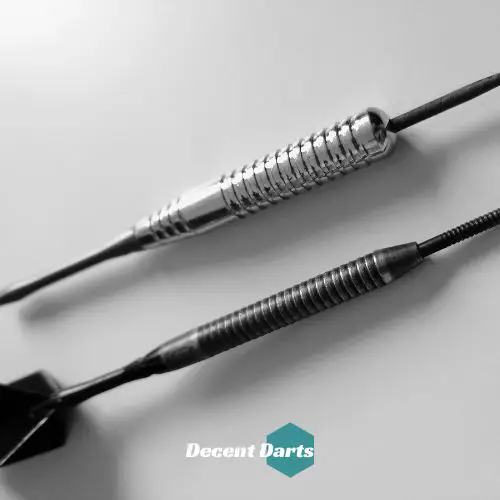
The last type we shall review is the nickel darts, commonly referred to as nickel silver darts.
Though they are called nickel silver, they do not have silver. People call them nickel silver due to their silverish appearance.
Like darts made of brass, nickel darts are also anti-corrosive and ideal for new and intermediate darts players.
The first set of darts I ever owned was a nickel silver set, however, it must have been by chance because I’d rarely seen them sold again. I also persisted with them for far too long before upgrading to tungsten.
That minor upgrade made me a much more accurate player almost instantly!
However, nickel darts are more expensive than brass darts but cheaper than tungsten darts.
Since they are denser than brass, nickel darts are slimmer and smaller than brass darts. Due to this smaller size, nickel darts can be grouped well but they are still not even close to the slim profile of a tungsten dart.
I own the same weight dart for both nickel and tungsten and you can clearly see that a nickel dart is significantly and noticeably larger. This can make it hard to group darts for consistent and high scoring.
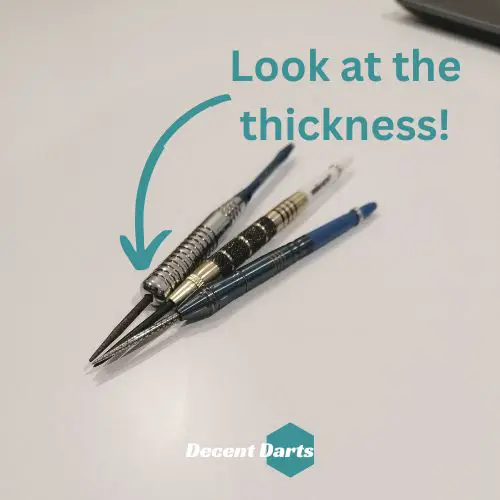
Tungsten vs. Brass vs. Nickel Darts: Which one is the Best?
When it comes to darts, there are various features you should consider before you buy. The main factors include:
- Weight: The weight of the dart determines how you throw it and the accuracy level. The main factor determining the weight of darts is the material used to make them. Most darts weigh between 16-26g. The heavier it is, the straighter and more accurate it will be.
Guide – Are heavy or light darts better
- Length: The length depends on your preferences and expertise. If you grip with more than three fingers, you will go for longer darts and vice versa.
- Grip: You should also consider the barrel material and style, which will determine the grip. Knurled, ringed, or bumpy barrels offer better grip.
- Material: The common materials used to make darts are Brass, Nickel, and Tungsten. These three types have different prices and properties.
As you’ve seen, the material used in darts plays a huge significance in selecting the best darts. Tungsten is the most recommended material by experienced and professional players.
Tungsten darts are the best because of their high density, durability, and slim size.
Professionals prefer using tungsten darts because they are small-sized, making it possible to group them tightly on the dartboard and increase scoring.
Though tungsten darts have the best features, they are more expensive than other darts. Therefore, most beginners prefer brass darts since they are very cheap.
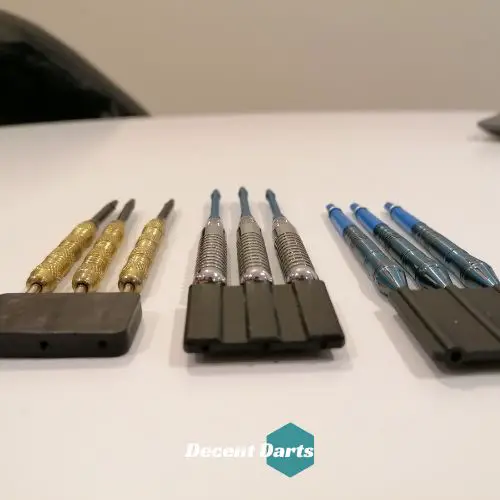
Final Thoughts
Darts game is still gaining popularity across the globe, and therefore it is important to have basic knowledge of the game. If you plan to purchase a dartboard, you will get standard brass darts to start your darts journey.
This is fine if you’ve never played darts before and just want to throw at the board but once you get a bit more experienced, you’ll soon learn that there are noticeably better darts on the market.
If you’re reading this and have decided you want to play competitively, we’d recommend getting yourself some tungsten darts.
These darts will improve your game and save you money since they don’t require regular replacement due to damage.
To help, check out our roundup of the best tungsten darts

